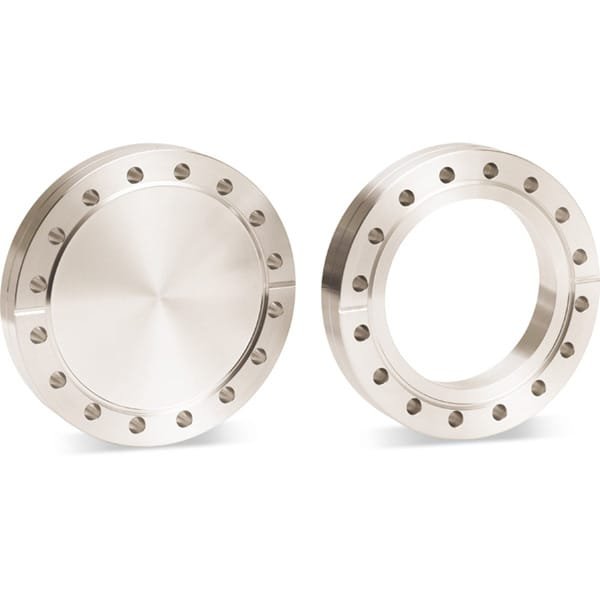TFM CF Flanges: A Standard for High Vacuum and UHV Applications
The TFM CF (ConFlat) flange is recognized as the industry standard for high vacuum (HV) and ultra-high vacuum (UHV) applications. This versatile flange system supports a variety of gauges, instruments, accessories, and feedthroughs, making it a crucial component in various vacuum setups.
What is a Blank (Blind) Flange?
A blank or blind flange is a solid, disc-shaped fitting used in vacuum systems to seal off unused ports or tubing sections. These flanges can be machined to create custom designs to meet specific operational needs.
Seal Mechanism Explained
The sealing mechanism of TFM flanges utilizes a knife-edge that is machined just below the flat surface of the flange. When bolts are tightened in a flange pair, the knife-edges carve annular grooves on either side of a soft metal gasket. This action causes the extruded metal to fill any machining marks and surface imperfections, ensuring a leak-tight seal. TFM seals perform effectively across a pressure range of 760 torr (103 mbar) down to < 1 x 10^-13 Torr (< 1.3 x 10^-13 mbar) and can withstand temperatures ranging from -196°C to 450°C, depending on the materials used.
Flange Size Nomenclature
In North America, TFM flange sizes are typically identified by their outer diameter (O.D.), such as the DN75CF, which has an O.D. of 4.625 inches. Conversely, in Europe and much of Asia, the nominal internal diameter (I.D.) of the largest tube that can be welded to a bored flange is often used for reference.
Types of TFM Flanges
TFM provides four primary versions of CF flanges to cater to different applications:
Fixed Flange
This design is a one-piece unit where the orientation of the bolt holes is fixed concerning the fitting. It is ideal for situations that require a specific alignment.
Rotatable Flange
A rotatable flange consists of two components: an inner weld ring and an outer bolt ring. This design allows the bolt ring to rotate around the inner weld ring, facilitating easier alignment during installation.
Both fixed and rotatable flanges can be tailored with a choice of through (clearance) holes or tapped holes, providing flexibility for various configurations.
Applications of TFM CF Flanges
TFM CF flanges are essential for maintaining vacuum integrity across multiple industries, including semiconductor manufacturing, materials science, and research laboratories. Their robust sealing capabilities and adaptability make them indispensable in environments where high or ultra-high vacuum conditions are paramount.
Ordering Table
| Flange Size/OD | Type | Flange Material | Part Number |
| DN125CF (6.75" OD) | Fixed | 304L SS | F0675X000N |
| DN125CF (6.75" OD) | Fixed Tapped | 304L SS | F0675X000NT |
| DN125CF (6.75" OD) | Rotatable | 304L SS | F0675X000R |
| DN125CF (6.75" OD) | Rotatable Tapped | 304L SS | F0675X000RT |
| DN125CF (6.75" OD) | Fixed | 304L SS | F0675X400N |
| DN125CF (6.75" OD) | Fixed Tapped | 304L SS | F0675X400NT |
| DN125CF (6.75" OD) | Rotatable | 304L SS | F0675X400R |
| DN125CF (6.75" OD) | Rotatable Tapped | 304L SS | F0675X400RT |
| DN125CF (6.75" OD) | Fixed | 304L SS | F0675X450N |
| DN125CF (6.75" OD) | Fixed | 304L SS | F0675X500N |
| DN125CF (6.75" OD) | Fixed Tapped | 304L SS | F0675X500NM |
| DN125CF (6.75" OD) | Fixed Tapped | 304L SS | F0675X500NT |
| DN125CF (6.75" OD) | Rotatable | 304L SS | F0675X500R |
| DN125CF (6.75" OD) | Rotatable Tapped | 304L SS | F0675X500RT |
| Flange Size/OD | Type | Flange Material | Part Number |





Reviews
There are no reviews yet.